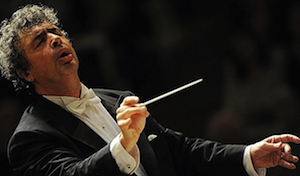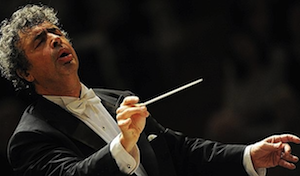
Talking with Semyon Bychkov is like conversing with a Talmudic scholar. Bychkov is a conductor who approaches every note from a place of profound contemplation, not only of the musical phrase, but also of a work’s larger, extra-musical implications.
It’s no wonder that a man whose website presents his biography as a seven-step evolutionary journey recently received glowing reviews for his Nov. 11 performance of one of the most moving works ever to address the costs of war, Benjamin Britten’s War Requiem. Two of the press comments inspired by the experience — “The tears threatened to become sobs, and self-restraint made just listening hard work” and “Throughout, Semyon Bychkov’s expressive baton and sometimes his sculpturing hands were an inspiration … one of the greatest performances of anything to come my way in forty years of concert-going” — are representative of what left the audience contemplating in silence at the work’s premiere in Coventry Cathedral in 1962.
Your welcome return to the San Francisco Symphony to conduct the War Requiem on Nov. 27 and 30 follows a wonderfully received performance in Great Britain. How many opportunities have you had to conduct the piece over the years?
I conducted it the first time in Paris in 1992 or 1993, when I was with the Orchestre Paris. Just after that, I did it in Munich with the Bavarian Radio Orchestra. Then, for many years, I stayed out of it.
Several years ago, I was asked to do this concert in London on Armistice Day [which took place on Nov. 11, 2013]. I said yes, and realized that I had to go back to the piece. We also organized performances for me in Rome, Florence, Paris, and Madrid.
Have you used the same soloists for all the performances?
Roderick Williams, the baritone who is singing in San Francisco, sang it with me in the Italian performances and in London. Otherwise, sometimes they were the same, and sometimes different. I have never done the piece with either soprano Christine Brewer or tenor James Gilchrist. I did work with James Gilchrist once, a long time ago, but I’ve yet to work with Christine Brewer.
Britten divided his musicians into three groups — soprano soloist and choir accompanied by a full orchestra, baritone and tenor soloists accompanied by the chamber orchestra, and boys’ choir accompanied by a small “positive” [movable] organ. The latter was ideally situated some distance from the full orchestra to produce a more distant sound. Are you able to accomplish this in Davies Symphony Hall?
I’ll place the two orchestras in the same way I did in London and Madrid. The chamber orchestra will be to my left, and the first violins of the orchestra will begin more or less where the second violins normally sit. A cathedral acoustic allows the echo or distance effect they achieved in Coventry, but other venues may not.
I’m absolutely open to any combination of art forms that reveals all kinds of different elements of the story as it is being told.
The War Requiem is often conducted by two conductors, although it can also be conducted by one, as it is in my case. What is important is that there are three worlds that are brought together. The first is the world of the two male soloists with the chamber orchestra — the two enemies that fought in the war. Then there is the world of the big orchestra and the choir, represented through the Requiem Mass. Then there is the world of children and angels and hope, represented by the children’s choir. It is the first time in music, to my knowledge, since Parsifal of Wagner, where time and space exist in the same place at the same time, if you will, but in different layers.
When you say you “stayed out of” the War Requiem for many years, was that intentional, or just a result of scheduling?
It was an intention. It is the kind of thing that requires time to mature. You have to do other things, so that when you come back, you come back to it on another level.
What I was able to do with the piece in the early 1990s had to do with what I had lived at that time. Interestingly, [Dietrich] Fischer-Dieskau, who was the first baritone interpreter of the piece, came to the performance in Munich because his wife, Julia Varady, sang it with me. We had a talk the next day, and he shared very, very valuable thoughts with me about the interpretation of the piece. It was terribly important, because the closest you can get to a [deceased] composer is through someone who was with him at the time of the creation.
Now, many years later, I had to practically relearn the piece because there is so much that I lived with in the meantime. Something that I found that was absolutely amazing is that Decca has reissued the recording of Britten conducting it with Galina Vishnevskaya, Fischer-Dieskau, and Peter Pears, along with several tracks of the recording sessions.
Is there hope in this piece? If the past is our proof, there is no hope, because it always comes back to the same thing: killing and destruction.
You should hear them, because it’s really unbelievable. You hear Britten speaking to his colleagues and asking them to do various things. He uses an upper-class kind of English language with an extraordinary courtesy, extraordinary humor, and extraordinary diction and clarity of what it is that he wanted to hear from them. It’s invaluable information for an interpreter to have, because it comes from a composer who was also an interpreter himself. A greater gift than that we couldn’t receive from Decca.
Then you see what he was asking is actually in the score. In this case, one must trust the score, because it is confirmed by what he was asking.
Testament has just released the premiere performance, in which Heather Harper took Vishnevskaya’s place after the U.S.S.R. did not permit her to travel to the U.K. Only later was she able to travel to London for the recording, thus realizing Britten’s intent to demonstrate international unity by having, as his soloists, an Englishman (Pears), a German (Fischer-Dieskau), and a Russian (Vishnevskaya).
It’s a performance I would really love to hear, but I didn’t have a chance yet. I’ve seen photographs of the performance, and it’s very touching.
The War Requiem is connected to both World Wars … It is, if you will, the cry of the heart against death, which is imposed, and for life.
I’ve been looking at Paul McCreesh’s new recording on Signum, and each page of text and translations faces a different photograph from World War I. Have you ever considered combining visuals of the time with a performance you’re conducting?
I haven’t done so, but I’m absolutely open to any combination of art forms that reveals all kinds of different elements of the story as it is being told.
As you approach this performance in the Britten centenary year, do you feel a great sense of responsibility?
Yes. Of course. I feel it for every piece of music I perform, as I choose to perform only music without which I cannot live. The reason I say I “cannot live” is because it represents the most important achievements by its creators, which is why you then feel the same responsibility, whatever the piece. It doesn’t mean that you will give it the same treatment, because they’re all different, but the responsibility is always the same.
In this case, the War Requiem is connected to both World Wars, which Britten lived through, and in which America has participated, as well, and not only in Japan. It is, if you will, the cry of the heart against death, which is imposed, and for life. That is a sentiment which is known to everyone and anyone.
One can take all types of positions on Britten’s pacifism, and I’m not here to either defend him or criticize him. But what is most striking about the incredibly moving poems of Wilfred Owen that he chose is one line that comes at the very end, when the baritone says, “I am the enemy you killed, my friend.” Think about it. In the space of four words we hear the juxtaposition of “enemy” and “friend.” And the meaning is, if I am the enemy that you killed, then you are my enemy too, correct? And yet I call you “friend.” “I am the enemy you killed, my friend.” It is in, a way, an alternative.
When I reflect on the meaning of the piece, I must ask myself: Is there hope in this piece? If the past is our proof, there is no hope, because it always comes back to the same thing: killing and destruction. But the present depends upon us to a certain extent, and therefore determines the future. So maybe, after all, there is hope.
I’m terrified of banalization of any work of art, and words are really difficult to come up with that will not make it trivial. That the War Requiem is timeless is simply because life itself and our existence are connected to the themes that are raised in it. For as long as people go on killing each other, it will remain very needed, because it’s a reminder of how senseless this whole thing is. One must have an alternative to this endless slaughtering of people who, most of the time, have no say in the decisions being made about their lives in a most direct physical shape and form.
My own belief is that each positive thought and act, no matter how small, makes an impact, because everything is cumulative.
Yes. That’s exactly right. And that’s what I mean when I say that the present does depend on us. It is the present that determines the future. That means there is hope.
Your website talks a lot about “getting to know the streets” of the different communities and countries in which you’ve lived and worked. I live in an area of East Oakland where there have been two shootings in the period of a month or so. In one, an infant’s forehead was grazed by glass from a shattered car window; in the other, bullets went through two vehicles. How do we translate the profound themes of the War Requiem to such a context? How do we get this awareness of life and death out there?
I think a lot about such things. I was in Los Angeles last night, speaking with the man who was driving me. I asked him if he ever drove through the dangerous neighborhoods. He said, “Yes, I do.”
I said, “What do you feel there?” He said, “A lot of angry people. Really, a lot.”
One thinks of little kids who have no choice in deciding whether or not they will be born. Once they’re born, they have no choice in the kind of home they will be born into. A lot of those families are broken families with nothing but misery or trouble. These little ones thus grow up with the idea that the whole world is like that.
If only one could find a way of showing an alternative to that senseless violence and misery and unhappiness. It’s all a question of education, and showing that there can be hope. Some who are strong enough and intelligent enough manage to find the ticket to real life; the majority don’t. I don’t have any better solution than other people who are concerned with such things. But one cannot just give up, because their misery becomes our misery, sooner or later.

